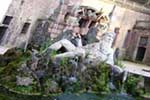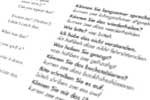history
550,000 BC In 1907, the jaw-bone of homo heidelbergensis (precursor to the Neanderthal Man) was found in a wall just south of Heidelberg. This is the earliest evidence of human life ever found in Europe.
5th cent. BC The Celts inhabit the area, building a fortress and place of worship on the Heiligenberg.
80 AD The Romans establish a permanent camp on the right bank of the Neckar. The first civilian settlements develop under the protection of the camp.
260 The Romans are driven away by the Alemannic tribe
769 The village of "Bergheim" is first mentioned.
1155 Konrad III, from the house of Hohenstaufen, takes possession of the oldest castle and settlement from the Bishops of Worms, establishing the Palatinate line. (The Palatine Electors were powerful princes who ruled this area of Germany during the period of the Holy Roman Empire)
1196 Heidelberch is mentioned in a deed from the Schoenau Monastery for the first time.
1214 The county of Palatinate is taken into the Wittelsbach family under Duke Ludwig I of Bavaria.
1255 Rudolf I becomes Count Palatinate.
1303 A document shows record of a castle located where the present-day castle ruins stand.
1329 The Palatinate is separated from Bavaria under the "House Treaty of Pavia". The honour of participating in the election of the emperor is to alternate between the two dynasties. Rudolf II ("the Blind") becomes the first Prince Elector of the Palatinate, and rules jointly with Ruprecht I until 1353.
1359 An Imperial Law named the "Golden Bull" grants the Count Palatinate the rank of Prince Elector.
1386 Prince Elector Ruprecht I founds Heidelberg University. It is the oldest university in present-day Germany and the third university, after Prague and Vienna, to be founded in the whole German speaking part of central Europe.
1400 Building work starts on the Heiliggeistkirche (Church of the Holy Ghost); Prince Elector Ruprecht I becomes King of Germany (Ruprecht III). After his death in 1410, the Palatinate is divided between his four sons.
1462 Prince Elector Friedrich I "The Victorious" defeats the Count of Baden and the Count of Württemburg in the Battle of Seckenheim.
1518 Luther defends his 95 Theses.
1556-59 Prince Elector Otto Heinrich transforms the castle into a splendid Renaissance building, considered one of first in Germany.
1563 The Heidelberg Catechism becomes the textbook of the reformed faith.
1610 Prince Elector Friedrich V adds the famous Schlossgarten ("castle garden")t, the Englischer Bau ("English Building") and the Elisabethentor (gate) to the castle.
1618 Thirty Years War begins
1619 Friedrich V, 'the Winter King', is elected King of Bohemia, but is deposed when he loses the "battle of the White Mountain" against the Emperor's army in 1620.
1622 The imperial general Tilly conquers the town and castle of Heidelberg. Rule of the Palatinate is given to the Bavarian Duke, Maximilian, who rules until the end of the Thirty Years War in 1648. Warfare robs the state of three-quarters of its population.
1623 The famous "Palatinate Library" (3,500 manuscripts and 5,000 prints) is carried off by imperial troops and is given to the Pope as war booty.
1648 Peace of Westphalia: Bavaria maintains control of the Upper Palatinate, but an eighth position of Elector is created for the Palatinate. Prince Elector Karl Ludwig rebuilds the castle and university and grants religious freedom to the Lutherans.
1685 The Palatinate-Neuburg line succeeds the Palatinate-Simmern line with the death of Prince Elector Karl II. King Louis XIV of France, however, tries to claim the Palatinate inheritance on behalf of his sister-in-law Liselotte (daughter of Karl Ludwig), but without her consent. Liselotte is married to Louis' brother, and Louis' intention is that the Palatinate should fall to France, thus triggering the War of the Palatinate Succession (1688 - 1697).
1688 French troops capture Heidelberg destroying the castle and the town as well as villages and towns in the Rhine plains.
1693 King Louis' troops conquer Heidelberg again, this time blowing up all the fortifications and burning the town to the ground.
1697 The inhabitants of Heidelberg start rebuilding the city on the old gothic layout, but in the Baroque style.
1720 Prince Elector Carl Philipp moves his residency to Mannheim after religious disputes with the citizens of Heidelberg.
1742-99 Karl Theodor rules as Prince Elector. Throughout his reign, he builds the first stone bridge over the Neckar (Alte Brücke - 1786-88), works to develop the University library, and starts rebuilding the castle. The Karlstor gate (1775 - 1781) was erected in his honour.
1764 Lightning strikes the castle, burning it down and making it permanently uninhabitable.
1803 The Imperial Deputation Decree reorganizes the German states, placing Heidelberg under the control of the Grand Duchy of Baden. Karl Friedrich re-energizes the university, renaming it "Ruperto-Carola", in honor of the two founders.
1810 The French emigré Charles Count of Graimberg starts working on conserving the castle ruins.
1815 After the fall of Napolean, the "Holy Alliance" is formed in Heidelberg by the King of Prussia, the Tsar of Russia, and the Emperor of Austria. In their honour the castle ruins are illuminated by an enormous wood fire.
1840 The railway line from Mannheim to Heidelberg opens.
1860 Castle and bridge lit up by "Bengal fire" for the first time.
1945 US Army takes over control of the city. It eluded bombing during the war due in part to the fact that General Patton liked the city so much. The city also becomes the headquarters for the US Armed Forces in Europe.
1978 The Hauptstrasse (main street) is turned into a pedestrian district. The city starts work on an extensive modernisation of its old central area.
1986 The Palatinate Library is returned to Heidelberg for the 600th anniversary of the University.
1996 Heidelberg turns 800 years old
Today Heidelberg has a population of around 150,000, with more than 39,000 of them students.








